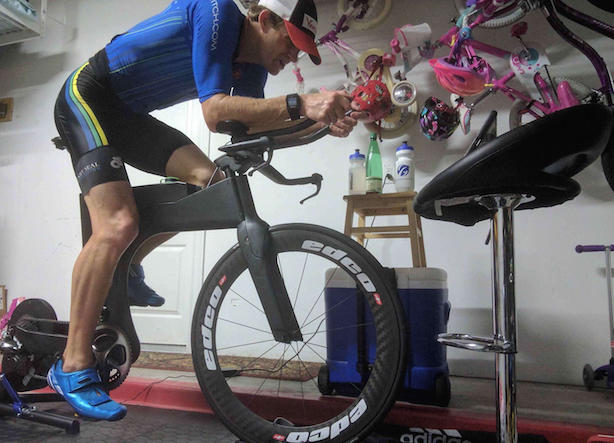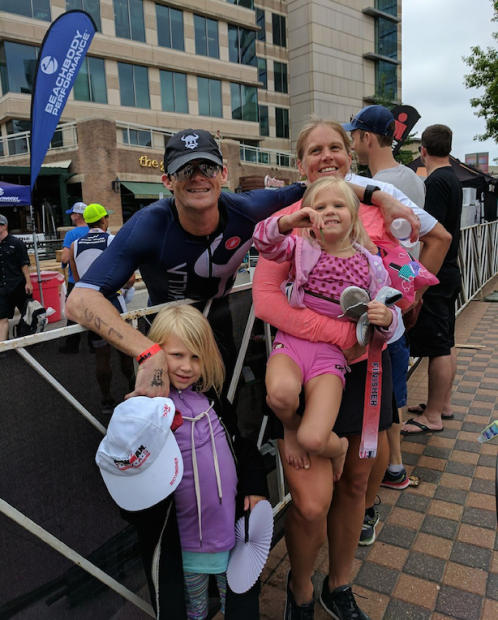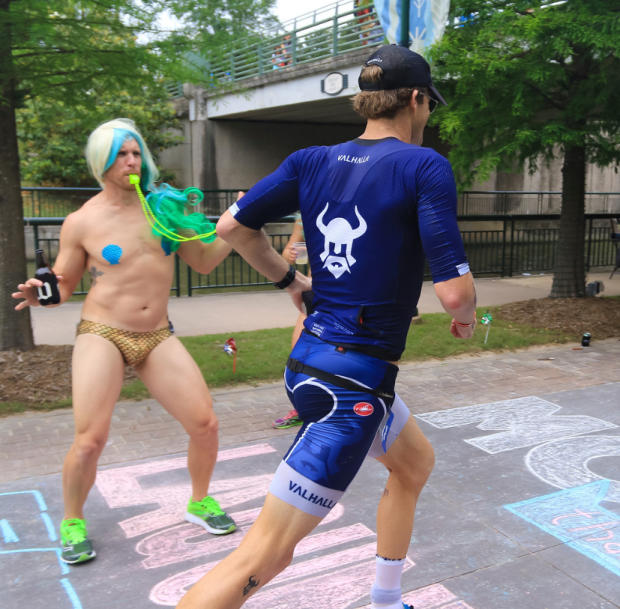The Nine Hour Per Week Ironman Training Experiment
By the time you read this you have heard a few thousand times about the stellar conditions served up at Ironman Texas this past Saturday. Warmer temperatures earlier in the week heated Lake Woodlands up enough to make it a non-wetsuit swim but otherwise the addition of the Hardy Toll Rd which made for a flat and fast bike course coupled with overcast and cool-for-Houston temps made it a fast day for many (5 pro men went under 8 hours!).
The ideal conditions certainly played into my favor as well and I finished in less than nine and a half hours, right about where I guesstimated I might, as long as nothing disastrous happened. I had invested a max of nine hours per week into my training in the three months leading into the race and while I believed with a great race I could have flirted with a sub-nine hour day, I knew I could not afford to take any risks or burn any matches.

I’ve got a fair bit of experience in racing Ironman having completed a dozen of them between 2002-2009 but hadn’t done one in seven years. I think this time away from the distance was a blessing as I was able to unlearn a lot of mistakes I had repeated in past races. For example, I used to love pushing the bike hard, too hard, and this would leave me completely knackered for the marathon. Given most of my training weeks consisted of 2-3 hours of cycling total, I considered the bike leg to be the biggest question mark for race day execution so had to respect the distance and pace the effort with extreme caution. I would not have previously considered that approach.
While many athletes put in tapers of one to three weeks before an Ironman, I did not put in enough hours of training in my legs to warrant backing off during race week. I stuck to my typical training week leading up to race day. I was neither confident or in a panic as showing up motivated and uninjured was my major goal. I am a firm believer that arriving motivated counts for a lot more than we can quantify. With mind and body happy, I focused on avoiding falling victim to a few potential snares I thought could cause a race day implosion.

CRAMPS. This was my biggest concern as I am a habitual cramper. I get them while swimming, cycling and running, and am often jolted awake in the middle of the night by them. I get them in training and also in most races lasting longer than an hour. Last year, my quads and calves locked up near the halfway point at ÖTILLÖ (an Ironman-like event from a time spent on course perspective), and my teammate, David Thompson, and I were forced to limp our way to the finish. While they typically take over my calves or quads, I occasionally get them in my hands while swimming and even in my toes, as happened at mile 12 of a half marathon a few weekends ago.
What did I do to prevent them? I focused on hydrating with electrolytes throughout race week. My go-to hydration product before, during and following training sessions was Precision Hydration and their 1500 (for the saltiest sweaters) based on the free sweat test I took on their website and the subsequent suggested usage their customer service reps provide. Our club had Jordan Rapp as a guest speaker during race week and his nutrition partner, First Endurance, sent a bunch of product as handouts for attendees so I packed their EFS cramp prevention single serving packets for the bike leg too. I took a HOTSHOT 15 minutes before the swim start and carried a handful of bottles with me on the bike and run and had a few extras stashed in my special needs bags too. All of them were put to good use. I had previously used HOTSHOT during my training for ÖTILLÖ throughout the muggy Houston summer last year and while it didn’t eliminate cramps completely, it helped prevent them from occurring as frequently. This may have been a bit excessive but I didn’t cramp at all throughout the day.

PACING: As mentioned earlier, without a huge foundation of miles and hours of training in my legs, I had to be very aware of my pacing throughout the day. My cycling training using TrainerRoad’s Full Distance Triathlon low volume plan focused on raising the ceiling on my high end fitness with our strategy being to race at a significantly lower percentage of my FTP value on race day. In theory, the effort of cycling at far lower power would be perceived as being easier, and allowed me to make it through the bike leg in good tick. I committed to checking my ego at the door and let a seemingly endless line of hammerheads ride away from me on the Hardy Toll Road drag strip. I figured I might see some of them again but certainly many were beasts and were gone for good. I stuck to my plan, maintained a consistent effort throughout the bike, and when the stiff headwinds kicked up in the last 20 miles, I found myself catching a lot of folks who likely went out too hard.
Pacing on the run is an interesting topic because it is heavily tied to how the bike leg goes. If previous Ironman marathons were any indication of performance, I always tended to cycle way too hard leaving little juice in the legs for the run. My conservative pacing on the bike on Saturday allowed me to get off the bike and feel relatively okay. While I never felt I had any pep in my step, I chugged along in “steady eddy” mode, only walking through aid stations to stay on top of nutrition. The first half of the marathon I took two cups of water and two cups of Gatorade Endurance with my Precision Hydration salt tabs and the second half switched to water and Coke. I never hit a low point, but I never felt great either.

RIDING OUTSIDE. All my riding was completed indoors these past nine weeks on a smart trainer. I was confident in my bike handling abilities (which I’ll add, doesn’t preclude anyone from crashing) but this also meant there were plenty of “firsts” which I didn’t practice in training. Riding surrounded by other cyclists, dealing with the natural elements like headwinds, tailwinds, crosswinds, negotiating various road surfaces, aid stations handouts (no one practices these, do they?), and even riding with a helmet, something I hadn’t done in over six months. It all went better than expected and without any drama.

The biggest takeaway I had from this experiment is that consistent high quality training sessions with an attention to recovery, injury prevention and executing a properly paced effort on race day while staying on top of nutrition throughout the day was a more than adequate return for the training time invested. There is no guarantee that doubling or tripling the volume of training would have provided me the strength and endurance needed to go considerably faster on race day. A plan with increased training load would have demanded more time and taken me away from other areas in my life I wanted to give my attention to: family, work and life outside sport. Could I go sub-9 hours with 20 hours of training per week? Maybe. Would that have meant neglecting other areas of my life? Yes. Was it worth adding an extra half an hour to my finishing time while enjoying the rest of my life too? Absolutely, yes.
I don’t believe this is a good plan for a first-timer but for many Slowtwitchers who have lots of lifetime miles and plenty of past race experience, I do not think it would leave anyone too far off their potential best mark. If I was a pro, I would not adapt this training style, but if you are an age-grouper hard pressed on time, it might be an option worth considering, especially if you are open for a fresh perspective. That is what it provided for me. Next up, seven hours per week!

A few questions from the ST Forum:
Q: What is your background?
A: I detailed this in an earlier post, linked HERE.
Q: What devices did you use?
A: I used a Polar V800 device during all training sessions and on race day to track my training time. My bike training was all completed indoors on either a Computrainer or Wahoo KICKR utilizing TrainerRoad’s Full Distance Triathlon low volume plan. Swim sessions were plans taken from Swim Smooth’s workout library. I used a Finis Tempo Trainer to focus on pacing. On race day, I used the Tempo Trainer during the swim with it set at 75 strokes per minute. I chose to swim off to the side of one of the main groups, not utilizing the draft benefit, and instead just focused on my stroke turnover. It was the most relaxing Ironman swim I have experienced and I felt as strong at the end as I did at the beginning. I used a Wahoo Elemnt Bolt computer on the bike to track distance and time but did not use a power meter. The run was also off feel, no heart rate monitor. The Polar V800 allowed me to track all my sessions in the Polar Flow Diary.

Q: What was your average accumulated TSS from your TrainerRoad workouts?
A: Weekly accumulated TSS ranged between 140 – 175 per week. The scheduled plan called for an average accumulated TSS of ~350-395 per week but my total was far lower as I only did the prescribed weekly long aerobic ride (3+ hour rides) one time during the nine weeks.
Q: How often did you swim, bike and run each week?
A: See graph for February, March and April training summaries (will post images from Polar Flow Diary in the forum link).

Q: Did you have any key sets in the pool to know you were ready?
A: Each week there was a set I completed that is a standard of most Swim Smooth programs called Red Mist. This was a tough weekly workout and prepared me for both the distance and intensity of the swim.
Q: Why did you decide to focus 40% of time swimming?
A: I believed the swim would offer the best ROI in terms of general fitness gains for overall race day performance while keeping me from getting injured. The traditional advice might be to cut back on swim sessions and time in the pool as it is only ~10% of the total day, but I think the fitness gains extended past the actual swim leg. It provided substantial cross over fitness into the bike and run legs without the risk of injury. I went into more depth on this in a previous post, linked HERE.

Q: What was the nature and quality of run sessions?
A: I am a fairly economical runner so focused on maintaining muscle memory. I did not focus on building fitness through running. My runs were done primarily on trails but this is where I prefer to run anyways as trail running forces the body to adapt to different surfaces and terrain. I did hop into two half marathon races with the goal of running them at slightly faster pace than I thought I would hold in the Ironman run. I know from past experience there is no way to replicate an Ironman marathon in training, so I did not even try. I just knew it would require a dedicated mindset, a healthy dose of suffering and staying on top of race day nutrition.
Q: What was your logic behind indoor bike rides?
A: I wanted to maximize my time on the bike and the best way to do that was on a smart trainer. For all the excitement riding outdoor provides, I did not want to lose time being stopped at lights, needing to change flat tires, risking crashes in groups or with vehicles, and any other number of elements that can turn a simple outdoor ride into an all day affair. The workout plan I followed through TrainerRoad focused on raising my fitness ceiling based off on an initial FTP test. Those hour long workouts were so intense and demanding I did not want them to last even five more minutes! The most difficult point of the bike on race day felt insanely easy compared to the two bike sessions I did with TrainerRoad each week.
Q: How close to peak cycling level are you?
A: My FTP is still in the ballpark of when I raced competitively. But from an endurance standpoint, I am 5+ years removed from my peak cycling years.

Q: What was the biggest drawback to the approach?
A: This approach required being very attentive and disciplined to not going over the nine hours of training time allotted. It did not allow me to be social in any of my sessions. I took a ‘get shit done’ mentality to each session. I can tap into this mode quite easily, but I did miss the social aspect of training with other people. I think endurance training is a great outlet to socialize and I missed that camaraderie. I does not always need to be serious.
Q: Would I attempt this again?
A: I think I could get a very similar result off 7 hours per week. Maybe I’ll try that later in the year. For now, I am really looking forward to dialing back on the distance and doing local sprint races, including CB&I Tri which takes place in The Woodlands in 10 days on a bite-sized version of the Ironman course.







Start the discussion at forum.slowtwitch.com